The Ultimate New Zealand Soccer Website | home
Football Ferns | Kiwi Women Overseas | NZ Women's Soccer Calendar | 2010 Women's Review | On This Day ... | 2023 Women's Review
2023 Women's Review
Why We're Where We're At -
A Personal View Of NZ Women's Football, March 2023
by Jeremy Ruane
Women's football in New Zealand is on the cusp of perhaps its greatest moment in the history of the game in this country, as the nation prepares to co-host the 2023 FIFA Women's World Cup Finals.
This is a to-die-for opportunity - the chance to welcome the female version of the beautiful game to our shores and promote it to a nation which both embraces and excels in women's sport like no other. Witness the likes of Dame Lisa Carrington, Lydia Ko, Dame Sophie Pascoe, Zoe Hobbs, the Black Ferns and the Silver Ferns, to mention just six global sporting success stories - there are many more - who hail from the little country which can, and often does.
Yet the Football Ferns, New Zealand women's football's shop window side, and the team on which the hopes of many in this "team of five million" will rest when push comes to shove in mid-July, is enduring any number of problems and concerns at present which threaten to both distract and detract from an event the sporting world will be watching.
The bad news is, there's no quick fix to the vast majority of these issues, a number of which have been festering over a lengthy period of time - indeed, decades where a couple of them are concerned.
In an ideal world, the Football Ferns will hit the ground running when they play the opening match of the FIFA Women's World Cup Finals on July 20 at the national stadium, Auckland's Eden Park, and do enough in their clashes with Norway, the Philippines (in Wellington) and Switzerland (in Dunedin) to advance to the knockout phase of the competition in August, and a potential encounter with the likes of Spain or Japan in the round of sixteen.
Less than five months out from those fixtures, it's safe to say Jitka Klimkova's charges are a long way from fulfilling those ambitions, as evidenced by a run of form which can hardly be described as inspiring - anything but!
Three wins and four draws from 29 matches since the last FIFA Women's World Cup Finals took place in France, a period which includes fourteen months of Covid-enforced international inactivity, is relegation zone form in most league competitions around the world, but that's our reality at the minute, and there's no getting away from it.
When one compares this form-line with that from the same period a decade ago - twenty wins and eight draws from 48 matches, it's easy to see how far the Football Ferns' stocks have fallen from a period in which they finished second and third at the annual Cyprus Women's Cup, second at the Matchworld Cup, earned our first-ever point at a FIFA Women's World Cup Finals and reached the quarter-finals of the 2012 Olympic Women's Football Tournament.
This period, which was overseen by John Herdman initially, then his successor, Tony Readings, also witnessed a 2-0 series win over China on home turf, and three draws with Australia - our best results against the old enemy since October 1994! - while we were within six months of defeating Brazil and China to win the Valais Women's Cup in Switzerland.
Those four years saw 106 goals scored in those 48 matches, and 59 conceded. Even omitting the 65 goals scored in seven matches against Oceania opposition in this period, 41 goals scored in as many matches on the world stage isn't something to be ashamed about, especially when compared with the current period - 14 goals scored and 64 conceded in the 29 internationals played since the last FIFA Women's World Cup Finals, none against Oceania rivals.
So, what's gone wrong? To which one must reply, "Where to start?", so many and varied are the issues which, together, have left New Zealand women's football in a situation where its national teams - and I include the Junior Ferns (U20s) and Young Ferns (U17s) in this - are no longer realising the levels, achieving the targets and fulfilling the ambitions their supporters have come to expect of them and eagerly want to see them accomplish.
The first thing to address is what was working so well a decade ago which contributed to what will always be regarded as the Football Ferns' golden era. Even more importantly, what foundations were established prior to this period of sustained success on the world stage coming about.
For this, one must go back in time, back to the darkest days of NZ women's football, a period when, following our hosting of the OFC Women's World Cup qualifying tournament in October 1998, we played just fifteen "A" internationals in eight years - unimaginable nowadays, but for some of the legends of our game, this was simply how things were back in their day, the prospect of playing 100 games for your country nothing but a wild fantasy.
Indeed, during this spell, the powers-that-be at the time deemed that our national women's teams' participation in the OFC qualifying tournaments for both the 2004 Olympic Games and the 2004 FIFA U-19 Women's World Cup Finals "wasn't financially viable".
This is not a misprint! And it's certainly no joke! NZ Soccer, as they were known back then, didn't enter New Zealand's representative women's teams in their two international competitions of the time because then CEO, Bill MacGowan RIP, considered that neither side would get past Australia in their respective qualifying tournaments, therefore didn't warrant the financial outlay required to both prepare for and contest the events.
Try pulling that manoeuvre today and there would be hell to pay! And rightly! The world was different two decades ago, however, and some aspects of it weren't necessarily better.
As an aside, the Junior All Whites were treated in like manner when the time came to enter the 2005 OFC qualifiers for that year's FIFA U-17 World Cup Finals, while even the All Whites weren't immune from a heavily reduced schedule during this penny-pinching period, playing just one international - against Australia in London - in a twenty-month spell.
One should never speak ill of the dead, but suffice to say, Mr MacGowan would never win a popularity contest in NZ women's footballing circles! For instance, it was his initiative to axe the week-long National Tournament and replace it with the (ironically far more expensive, given the frugal approach applied above) National Women's League competition, about which, more later.
He certainly wasn't a staunch advocate of the women's game - far from it! So when Australia was given the green light to switch Confederations from Oceania to Asia with effect from 1 January, 2006, it was one of the best things which could have happened from a NZ women's football perspective.
Why? Because it meant the national body would have to increase its investment in the women's game in order to take over from the "old enemy" as OFC's flagship women's footballing nation, and impress as Oceania's representatives at FIFA's various events, including the Olympic Games and the soon-to-be-launched FIFA U-17 Women's World Cup Finals.
Oz's switch-a-roo had long been earmarked, and as part of its preparations to assume the mantle of Oceania's foremost footballing nation, the national body established a Women's Football department, appointing former Football Fern Michele Cox to lead the charge.
Like her parents, Roy and Barbara, both of whom played such pivotal roles throughout the first three decades of the women's game's establishment, development and growth in NZ since the early 1970s, "Coxy" doesn't do half measures.
Just as in her playing days - she's forever the first name etched in my all-time-best NZ eleven, so influential was she on the park - Michele made things happen in her new role off the field, driving change which ultimately realised results from which we're still benefiting today. She was the Bid Chief whose efforts secured New Zealand the hosting rights of the inaugural FIFA U-17 Women's World Cup Finals in 2008, for instance.
Other things were established during her 3.5-year tenure which contributed towards the outcomes achieved in the 2010-13 era, most notably nightly training sessions on North Harbour Stadium's outer pitches for our senior and age-grade internationals under the all-seeing eyes of NZ's coaching staff. These were introduced prior to her appointment by NZF's then Director of Football, Paul Smalley, and Goalkeeping Coach, Mick Leonard.
Why this? In a nutshell, now as then, the game in this country lacks the size, resources and depth of both quality players and suitably qualified and experienced coaching personnel to justify having our elite on-field performers dotted around the countryside, training alongside players who, unfortunately, aren't as advanced football-wise as some of their peers.
Far better to have the elite performers gathered in one location, working in a professional environment each evening, challenging and being challenged by their fellow internationals and the cream of the country's coaching crop at NZF's Auckland base, thus raising the standards and performance levels of all involved … in short, all the benefits one expects such a focused environment to bring about.
For some, this pooling of resources meant personal sacrifice - relocating north rather than remaining in one's comfort zone, for instance. Short-term individual pain for NZ women's football's long-term gain. It wasn't popular with some, but the results realised within the decade speak for themselves - the practice clearly contributed to the successes achieved!
The current situation results-wise suggests said practice needs to be re-established in some way, shape or form, although such has been the progress in the women's game since then that there are clear differences between the way things are today and the situation which was in place when the NZ Elite Training Squad was established in 2005.
Overseas opportunities then were every bit as scarce as they were in Michele's playing days, when both she and fellow Ferns legend Maureen Jacobson were Kiwi women's footballing pioneers on the world stage, "Coxy" winning the German league-and-cup double with TSV Siegen in 1988-89, while "Jakes" won the Finnish championship with HJK Helsinki in 1988 before lifting the Women's FA Cup aloft in Millwall Lionesses' colours three years later.
Throughout the nineties and noughties, almost without exception our national representatives were locally based, so you could go and see them strutting their stuff on most Sundays during the football season.
The two clubs which did much more than most to foster and champion the women's game during these decades were Lynn-Avon United and Three Kings (now Auckland) United. Clashes between these sides swiftly became the most eagerly awaited duels of the season - no surprise when one considers that each could name a starting eleven (and occasionally a subs' bench) laden with NZ senior and age-grade internationals of current or recent vintage.
You'll never see that situation again, with so many of our senior players now based abroad. But while the likes of Michele, Maureen, Donna Baker (Odense BK), Rebecca Smith (Wolfsburg), Ali Riley (Rosengard), Ria Percival (FFC Frankfurt), Katie Rood (Juventus), Hayley Bowden (Chelsea), Amber Hearn (Arsenal), Sarah Gregorius (Liverpool) and Betsy Hassett (Ajax) enjoyed success at the highest levels of the club game in days past, very few of our current stars are playing for elite level teams.
By elite level, I'm talking top-shelf European sides who are playing in the upper echelons of the foremost league competitions in the likes of England, France, Germany and Sweden, as well as in the UEFA Women's Champions League, or their North American equivalents in the National Women's Soccer League and the International Women's Champions Cup.
While meaning no disrespect to the Ferns' players' current employers, who've afforded our top performers a foot in the door, the likes of Olympique Lyonnais, Arsenal, Barcelona, Chelsea, Portland Thorns and North Carolina Courage are the sorts of teams with whom our best players should be striving to secure contracts. Those clubs want the crème de la crème of the available talent in their ranks, and they're not afraid to invest heavily to get it.
The funds being ploughed into women's football in Europe particularly these days are nothing short of astronomical. England international Keira Walsh recently transferred from Manchester City to Barcelona for a record GBP 400,000, with City spending all that money and a bit more besides on three internationals, one each from Australia, Japan and Norway.
That's just at club level. Yes, it's a drop in the ocean compared to the telephone numbers you see being bandied around in the men's game, but one needs to bear in mind that women's football has only been a happening thing globally since the early 1970s - not long after the first GBP 500,000 transfer occurred in the men's game, some 85 years after the first-ever transfer fee changed hands in 1893!
On the international stage, one of the reasons why the upcoming FIFA Women's World Cup Finals will be contested by 32 teams for the first time ever is to accommodate the growth in the game in Europe, which boasts twelve of the contenders for the game's biggest prize (and to FIFA's credit, they are working towards realising equal prize money in their showpiece finals … but that's another story, one not even remotely linked to this wide-ranging review).
Many of those nations have envied the guaranteed spot Oceania enjoys at the top table of the women's game. Greater still are the grizzles from the fans of those nations, many of whom bemoan New Zealand's continued presence, pointing to their disappointing results at FIFA Finals and Olympics tournaments as reasons we should have to play off for the berth we've enjoyed ever since qualifying for the 2006 FIFA U-20 Women's World Cup Finals.
Such arguments are well-founded, but won't cut mustard with FIFA, whose desire to globally grow women's football has seen the world's governing body plough $US 1 billion into the game over the course of the last four years, with OFC's "All In" programme evidence of that funding in action in this area of the world.
The existence of the Wellington Phoenix women's team is further evidence of FIFA's funds being put to good use locally - another case of about which, more later, for at present, the focus is on what worked to make the Football Ferns' golden era in the 2010-13 period so successful.
Back to the Elite Training Squad environment, which allowed players to greatly improve their technical prowess and generally ready them for the task of taking on the world's best. From this emerged the Future Ferns Development Programme - yes, about which, more shortly where this is concerned, too!
I did say there were many issues which have played a part in the situation presently confronting the women's game. All have their roots in the things which worked in the period leading up to and during the Football Ferns' golden era, but, as invariably happens over the passage of time and with new and well-meaning contributors eager to put their own pawprints on proceedings en route …
What was once a tasty Spaghetti Bolognese recipe has turned into the footballing equivalent of Spaghetti Junction, and there is no clear passage out of the tangled web which gets us back onto the main highway and travelling full steam ahead once more! That is the situation facing Jitka Klimkova today, in a nutshell. No, I don't envy her either - hers is a very challenging position, make no mistake.
One of the best aspects of the Elite Training Squad set-up - eventually, but not initially - was that players could still play for their clubs each Sunday, which was where the Northern Premier Women's League plays - and continues to play - a major role in proceedings.
On my website is a page named "The Professionals", a listing of every Football Fern who has played abroad, for whom and when. With a handful of exceptions, every single one of those players has graduated to the world stage from the Northern Premier Women's League, a competition I consider the country's best league, one which has played a pivotal role in the development of our very best female footballers.
Regular readers of my match reports and commentaries will recall seeing the NPWL described as a "finishing school", the place where rough diamonds are polished, practices and processes perfected and footballing functions fine-tuned so that, when the opportunity to play abroad availed itself, elite Kiwi players were ready to spread their wings and fly, and make a solid fist of the chance which their efforts and self-sacrifices had earned them.
The element which sets the NPWL apart from its regional equivalents nationwide is the sheer intensity of the competition. Every game matters, and very few of them see teams afforded an armchair ride - the points have to be earned. There's no turning up knowing you've got the game won even before you've kicked a ball in anger, something which can't be said for matches in the central and southern regions.
It wasn't always like this, of course, such was the dominance of Lynn-Avon and Three Kings throughout the nineties and noughties. The intense rivalry between "The Old Firm" raised the standards for others to aspire to, and over the last decade or so the likes of Eastern Suburbs, Western Springs and Northern Rovers - both in their present form and via parent clubs Forrest Hill-Milford United and Glenfield Rovers - have risen to the challenge and made their mark.
Wellington United, Coastal Spirit and Dunedin Technical (now Dunedin City Royals) have also stepped up to the plate in this regard, as evidenced by their respective successes in the Kate Sheppard Cup in recent times.
When push comes to shove, however, the northern region is and has long been where the strength of the women's game in New Zealand lies, so it makes sense to channel our resources towards having our elite players based in that region and playing for clubs in that area of the country.
Which brings me onto FFDP, a programme which, while based on the Elite Training Squad programme, has, frankly, lost its way, and simply does not serve the game in the way that it should.
I get the overall idea behind and objective of FFDP - it allows NZF to have complete control over an individual's development, and ensures they're not being over-coached or over-played, something which all too easily occurs when clubs and schools football have an influence on proceedings.
But FFDP has a fundamental flaw - it takes players out of the club environment in which they've grown up and become the players that attracted them to the FFDP overseers' attention in the first place. As a result, they're no longer playing competitive club-based football week in, week out - a major no-no, which has taken away much of their enjoyment of the game.
In some cases, players have disappeared from the scene entirely. A couple of cases in point, both from the Young Ferns squad which stunned the world by finishing third at the 2018 FIFA U-17 Women's World Cup Finals in Uruguay.
Maya Hahn gave up on New Zealand and switched her allegiance to Germany - a big call, but that was her prerogative. As for team captain Aneka Mittendorff, who showed a maturity beyond her years and looked to be a nailed-on future Football Ferns captain and central defensive lynchpin, she's dropped off the radar completely - criminal! We can't afford to lose talented footballers of their calibre, but …
Players need to be playing regular competitive football, regardless of their training regimen. When FFDP commenced, there was an element of this when Gareth Turnbull oversaw the operation, in the form of competing against - and often beating - U-17 boys' teams in the Northern Region U-17 Conference Division, which the FFDP squad came close to winning in both 2017 and 2018.
Many of their games were played on Thursday evenings on North Harbour Stadium's outer oval, potentially making the players available for club play alongside and against their peers three days later. But that fear of club involvement just wouldn't go away …
Turnbull secured an opportunity to spread his coaching wings across the Tasman in 2019, and his assistant, Gemma Lewis, stepped up to the plate following his departure. Under her stewardship, the FFDP became a behind-closed-doors operation - no regular competitive fixtures or involvement in a league environment to apply the training ground workings in a match every week. Just concentrated training sessions … where's the enjoyment in that?
Club football is central to the success of the game in every football-playing country on the planet. It's the lifeblood of all sports, not just the game the world plays. It's where players get to play alongside and against their peers and - and this also applies to the coaching staff - test themselves week in, week out, with points, pride and performance-based standards at stake.
It goes completely against the grain to take players out of that environment and into one where none of these elements are part of the package. Pray tell where the fun is in that? How do you maintain your appetite for football in such an environment, when you're effectively off limits from all the aspects of the game you've enjoyed while growing up?
Therein lies the major failing of FFDP, and we're seeing aspects of it in the situation facing the Football Ferns at present. How many players do you see playing without fear? With a sense of enjoyment, joie de vivre and expressiveness about their play?
There's no fun in losing, of course, but one gets the impression that for some members of the squad, merely being a Football Fern is something of a burden at present, a cross some are struggling to bear, regardless of the results.
Is this because of the increased weight of expectation from playing on home turf, knowing that it's not just your family, friends and the women's football fraternity who are following your fortunes, but the entire nation, including the all-seeing, unforgiving mainstream media outlets, whose interest in the women's game has, for the bulk of the fifty years in which the code has been played in this country, been peripheral at best, and nigh on non-existent for the most part?
You should never get to the point where what you're doing is a burden in anything you do. When that happens, you need to step back, reassess, and go back to doing the things which gave you pleasure from what you're doing, and which give your life balance and perspective.
Case in point - myself. For around a decade from 1992, I provided heavy coverage of the men's game in this country, attending up to five games a weekend at one point, with men's action on Friday and Saturday nights and Saturday and Sunday afternoons, the solitary women's game I attended taking place on Sunday mornings.
However, it became a chore for me - it got to a stage around two decades ago where I no longer enjoyed reporting on men's football matches in this country. Yet I loved the women's game - have done since first discovering it in May 1987, and still do all these years later. So I started to reduce my coverage of the chaps' efforts, and replaced it with more women's coverage.
Hence why the women's game continues to be my prime focus where football in this country is concerned, with maintaining the records and history of the game here a close second, and coverage of selected men's football fixtures bringing up the rear in a three-horse race. I greatly enjoy what I do for the game, the women's game in particular, even though there's no financial reward for it. (All donations gratefully accepted!)
Enjoyment and fun have always been key elements of the Football Ferns' make-up. Some would say there's a bit too much focus on both given what's regularly posted on social media by the players; that there's an imbalance between business (i.e. the results side of the equation) and pleasure.
It's a difficult one, this, because social media is such an integral part of the lives of young people in particular these days, whereas those not quite as young regard it as a distraction at best, a necessary evil at worst, and certainly not something which should demand as much attention when your first job is performing on a football pitch - preferably with a win to show for your efforts come the final whistle - and those victories aren't being realised.
This draws attention to the team's culture, something which is integral to the Football Ferns. I cast my mind back to very early on in John Herdman's reign, back in 2007, and the theme of a squad gathering - "What makes us us?" It was from those sessions that the Football Ferns nickname
|
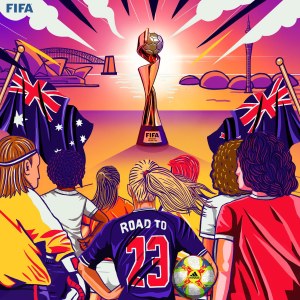 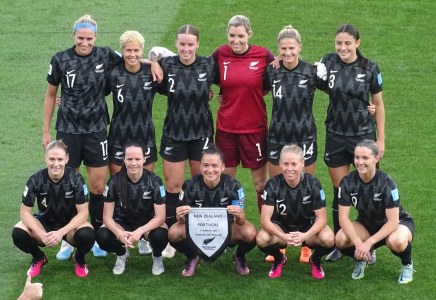 The Football Ferns' line-up prior to taking on Portugal
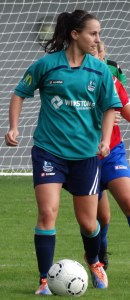 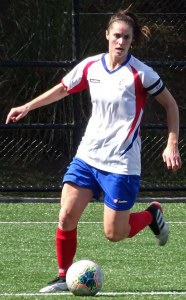 Hannah Wall and Steph Skilton
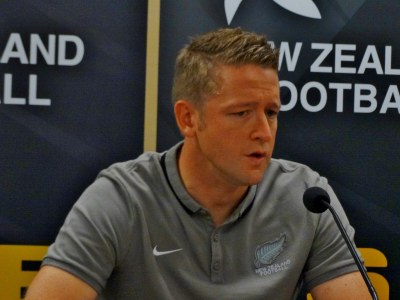 Tony Readings
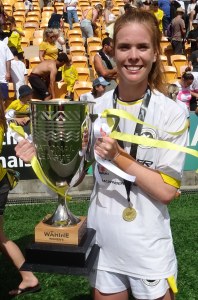 Tayla O'Brien
 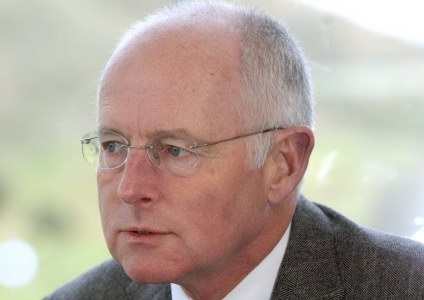 Bill MacGowan RIP photo source NZPA
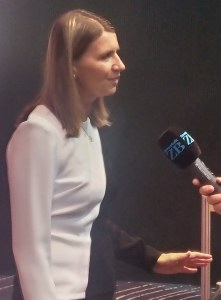 Jitka Klimkova
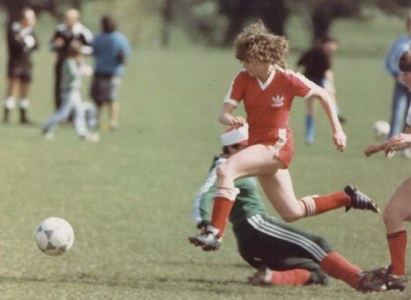 Wendy Sharpe in goalscoring action for Mt. Wellington
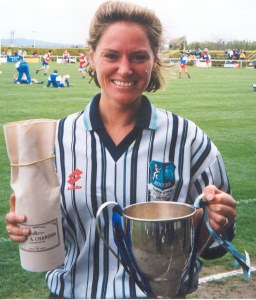 Michele Cox
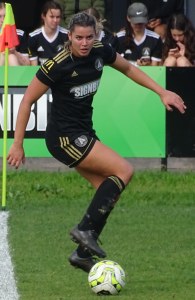 Martine Puketapu
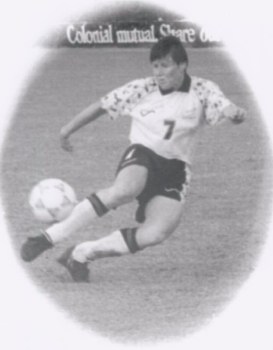 Maureen Jacobson photo by Eric Pritchard RIP
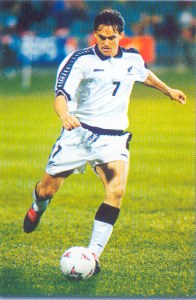 Wynton Rufer
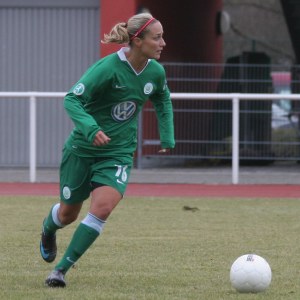 Rebecca Smith in action for Wolfsburg
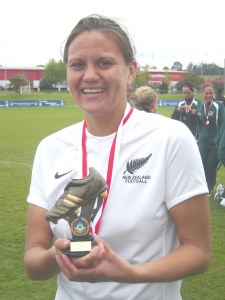 Amber Hearn
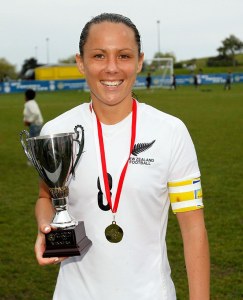 Hayley Bowden photo courtesy Phototek
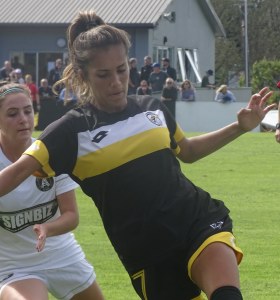 Chloe Knott
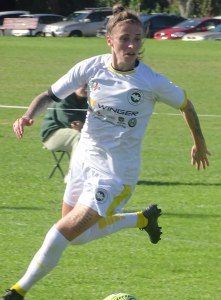 Rebecca Burrows
 Sarah Gregorius with the FA Women's Super League title
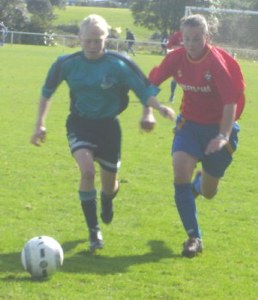 Betsy Hassett and Ria Percival in the thick of an "Old Firm" battle
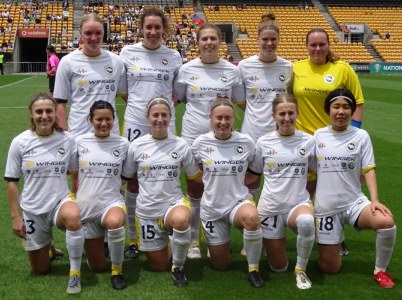 Eastern Suburbs, 2022 National Women's League champions
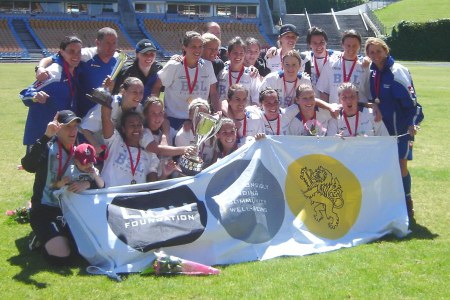 Soccer2, aka Auckland, 2006 National Women's League champions
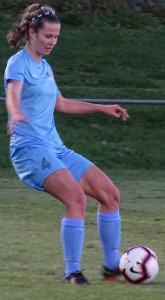 Aneka Mittendorff
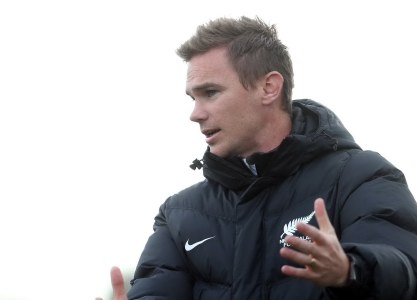 Gareth Turnbull
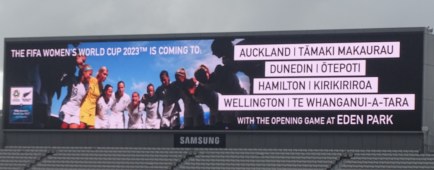 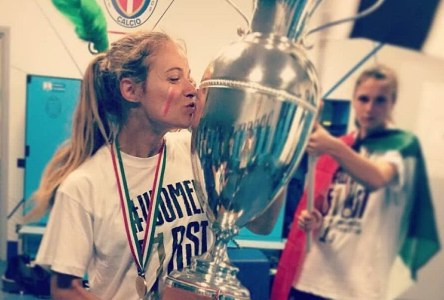 Katie Rood celebrates title success with Juventus
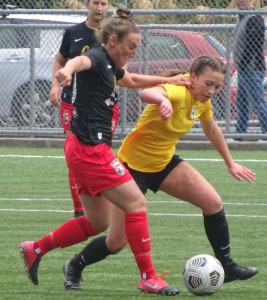 Annalie "Flea" Longo - a race against time fitness-wise
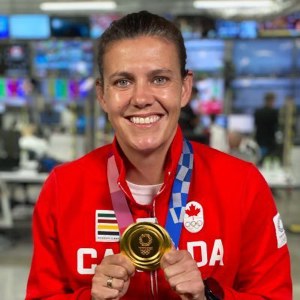 Canada's Christine Sinclair
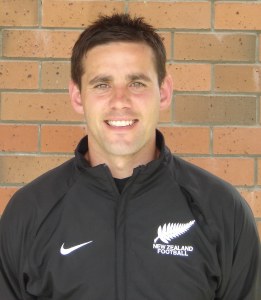 John Herdman
|
emerged - Annalie Longo came up with the moniker - and the team has been known thus ever since.
The gaffer was very aware of - and even more eager to embrace all aspects of - "The Kiwi Way" in the Ferns' identity, rightly recognising it as something unique to New Zealand and our nation's culture. Fast forward to the team's golden era, and "The Kiwi Way" was very much at the heart of what was achieved and how those successes were realised.
Five years further on, and the fleeting appearance on the scene of one Andreas Heraf, whose name will forever cause Football Ferns of the time - and fans, too - to grimace. The Austrian's approach to the job brought about changes in NZ Football's entire make-up, changes which are increasingly being reflected in women's sport globally.
In the eyes of some, his approach was what was required to drag the Football Ferns kicking and screaming into a new era. But that same approach was founded in a bygone era, one in which men were men and women knew it! And he certainly didn't embrace "The Kiwi Way", thus alienated himself early doors and was soon shown same - one of NZ Football's most expensive mistakes. (And there have been a fair few of those over time, as well we know!)
There are two other areas in which NZF has contributed to the current situation, one of which dates back a decade or so, the other is still being practiced. The latter first - the playing of players out of position, trying to convert them into something which they are not. In other words, square pegs in round holes.
Numerous are the instances of this occurring over the years, but there are two individuals who always spring to mind when this topic is raised, players who, were they employed in their natural positions, would be making a notable difference to the Football Ferns' fortunes right now, make no mistake.
Sadly, the powers-that-be thought it would be a good idea to convert Steph Skilton, a striker, into a central defender, and Hannah Wall, an attack-minded schemer, into a fullback. Little wonder both are no longer involved in the game, their enjoyment of it severely impacted by these bids to turn them into something neither clearly never was, nor was ever going to be.
Around the time these two were playing age-grade internationals, some of their team-mates were receiving post-Finals letters saying their services would no longer be required at senior international level - thanks but no thanks!
Put yourselves in the shoes of a Junior Fern who is not long home from representing NZ at the FIFA U-20 Women's World Cup Finals, and you open a letter personally addressed to you saying these words. How would you feel? Your senior international career over before it's started. Would you want to carry on playing the game you love, having had arguably your biggest footballing dream taken away from you?
Whoever came up with this idea clearly wasn't the sharpest tool in the shed! As time has gone on, however, that initiative, for want of a more appropriate word, has seen a steady stream of our age-grade internationals disappear from view, lost to the game.
The same players who, had they not been treated in this fashion, would, right now, be potentially thereabouts where Football Ferns' selection is concerned, and providing far more competition for places than has been evident for much of the last decade, during which folk have been clamouring for changes to the national team, their thinking being that some members of the squad had passed their use-by date.
It gave me great pleasure to see Tayla O'Brien make her debut for New Zealand against the USA at Eden Park in January, having answered the call with NZF needing to draft in numerous new faces to enable them to play these fixtures outside the international window. "TOB" was one of the recipients of the aforementioned letters …
Morals to the story: to players, never give up on your dreams, and to NZF, never give a player reason to give up on their dreams.
For many capped and uncapped players these days, those dreams include playing the game professionally, and the recent advent of a largely NZF-funded Wellington Phoenix women's team - born in September 2021, lest we forget - enables them to do so virtually on their own doorstep, as well as abroad.
The restrictions under which this team is having to play, however - for example, a limited number of Kiwi players, and a set number of Australian players - have certainly contributed to their overall disappointing showings to date. But the recent defeat of perennial title contenders Sydney FC is a real feather in the cap of a Wellington team which, it's fair to say, doesn't yet compete on a level playing field compared to their West Island-based opponents.
One wonders if that situation is set to change, in light of the prospect of an Auckland-based A-League women's squad coming to fruition within eighteen months, something which has come about while this review was being compiled. It's safe to say there'll be no shortage of potential recruits eager to join the new outfit, particularly given Auckland is home to so many of our internationals currently plying their trade abroad.
There's one element of Wellington's game which has let them down throughout their two seasons playing in the Australian competition - goalscoring. And, as mentioned much earlier in this review, it's a problem they share with the Football Ferns.
In the A-League team's case, they can resolve this issue with better recruiting - unlike on these shores, free-scoring strikers are ten-a-penny in the US college system, and many of Wellington's A-League rivals have taken advantage of that to bolster their prospects of competing for silverware. It's an avenue down which New Zealand's contenders need to travel.
Jitka Klimkova doesn't have that luxury. Consistent, proven goalscorers are rare birds in NZ women's football, and that's been the case throughout the first five decades of the national team's existence.
Wendy Sharpe retired in 1995, having set the standards for all future Football Ferns to aspire to by scoring 38 goals in 53 international appearances for her country, 34 of them in 47 "A" internationals.
It took eighteen years before her tally was bettered, Amber Hearn netting her 35th goal in her 74th "A" international as the Football Ferns thrashed China 4-0 to win the Valais Women's Cup in 2013. She went on to find the net 54 times for her country in 125 cap-earning fixtures, a record which will likely stand for all time.
In the ensuing years, Sarah Gregorius has drawn level with "Weed"'s benchmark tally, her match-winner against England in 2019 the 34th and final goal of an international career which concluded with exactly 100 caps.
No one else has come close to bettering Wendy's milestone, one achieved over the course of sixteen years in days when the national team played nowhere near as often as they do today. Imagine the tally she would have set had she enjoyed the playing opportunities her successors have done in these more enlightened days for the women's game.
Of the current crop of Football Ferns, Hannah Wilkinson has scored 27 goals, while Annalie Longo and Ria Percival have struck 15 apiece, one more than Betsy Hassett. No one else is even close to getting into double-figure territory at this point in time.
It's safe to say goalscoring has been a perennial problem for our national team on the world stage, and would have been even more so but for the efforts of two once-in-a-generation players who should never have to buy a drink wherever they go! (Guarantee they'll both love that line!)
How do we overcome this problem, however? For mine, it comes back to coaching, and in particular, what players are being encouraged to do when on the park. Goalscorers are unique players, relying on one's natural instinct and intuition to be in the right place at the right time to do the right thing by their team - that's not something you can coach. But it's something which can be coached out of you.
I refer back to my earlier comments about Steph Skilton and Hannah Wall being played out of position. And I'll add to the mix Martine Puketapu, a fabulously talented striker who lost her love for football in the US college environment, and has chosen to retire at the ripe old age of 25, having averaged a goal a game during her 107-match club career, as well as netting nigh on fifty more for other teams, 29 of those goals while sporting a silver fern over her heart.
If I was Jitka Klimkova I would be striving to move heaven, earth, the moon, the stars and the sun to lure "Marti" out of retirement so the Football Ferns have the ace in the pack they so badly need right now, and over the course of the next eighteen months - I'm thinking the Paris Olympics as well as our World Cup Finals.
She's a proven match-winner on the big occasion - her Kate Sheppard Cup-winning feats in 2012 and 2022 testify to that - and she's pretty much the total package as modern-day strikers go, combining power, pace, poise and precision with those natural instincts no striker can do without.
Goalscoring isn't the only element of the game which the wrong sort of coaching can stifle. The creative attributes are just as critical in this regard, if not more so - you can't score if you're not creating chances to score from, after all.
There is one aspect of football with which any number of coaches over the years, both here and abroad, seem to have great difficulty when putting together a national squad - embracing the gifted. The supremely talented. The exceptionally skilled. Or, to use the title of a book devoted to such players of English heritage, "The Mavericks".
Exhibit A in English football is and will always be Glenn Hoddle. 53 caps for England, a tally nowhere near the number he should have acquired. No less a similarly talented player than Michel Platini said that had Hoddle been born in France, he'd have won 150 caps - when it came to the on-field aspects of the game, Platini was rarely mistaken.
Closer to home, New Zealand has had its fair share of such players who offer that "X factor" which many of their contemporaries cannot. Think Alf Stamp. Peter Henry. Billy McClure. Wynton Rufer - a player of his calibre should boast far more than 38 appearances in the nigh on 200 matches played by the senior national side over the course of his eighteen-year international career. Far, far more.
Alas, this concern isn't confined to the men's game in our little corner of the world. Exhibit A where NZ women's football is concerned will always be Michele Cox, who played in just 23 of the 58 matches played by the Football Ferns during her international career. The reasons why aren't appropriate here, but suffice to say, the vision of Dave Boardman, NZ's coach throughout much of "Coxy"'s career, found little room for her creative instincts in his line-ups.
I've been dead lucky throughout my time to date in NZ women's football. The very first game I saw was a top-of-the-table clash between Eden and South Auckland Rangers in May 1987, and I went along purely out of curiosity en route to Eden Park to watch Marist thrash Ponsonby!
"Coxy" was on fire that day at Pollard Park, and women's football had a new fan long before the final whistle had blown! I hadn't seen a player as good as her in the men's game in this country for ages!
I didn't know it that day, of course, but her team-mates were among the very best in the country at the time, and formed the bulk of a New Zealand side which finished in a three-way tie for second place at the World Women's Invitational Tournament in Taiwan late that year, a competition which was the predecessor to the FIFA Women's World Cup Finals we know and love today. Yes, we were good back then. Very, very, very good indeed!
Fast forward to the turn of the century, by which time I was as deeply involved and invested in the women's game as I am today. Michele had just retired, and the hunt was on to find her heiress apparent as the creative genius in the national team.
Nearly an entire season had passed by with this issue unresolved when, in August, I attended the Northern Region U-17 Tournament at Bill McKinlay Park. Within ten minutes, not only had Amber Hearn grabbed my attention with the first of 22 goals she'd score that weekend, I'd found Michele's natural successor, a shy fifteen-year-old blessed with terrific vision who could run all day and had an eye for both a well-weighted pass and a goal from distance …
Hayley Bowden (nee Moorwood) would go on to become the youngest Football Ferns captain, and was the first player to make a century of appearances for the country's shop window women's team in all fixtures, eventually representing NZ 107 times at senior level, 92 of them in "A" internationals.
Injury contributed significantly to her premature retirement, sadly, but Hayley was instrumental in the Football Ferns' golden era. Like her predecessor, she was an extremely special talent - a box-to-box midfield general who could change the course of a match with her creative prowess, yet supplemented those silky skills with a steely resolve. In effect, three players in one.
Such players are rare indeed. It goes without saying Hayley has never been replaced in the Football Ferns. It's no coincidence that within a year of her retirement, the form slump in which the national team finds itself right now had commenced.
Frustratingly, there have been a couple of Junior Ferns who could have gone some way to filling the void if given the opportunity during the ensuing decade. Hannah Carlsen's talents were sadly thwarted by a serious concussion injury which forced her premature retirement, while naturalisation issues have been the bane of Chloe Knott's New Zealand career to date. Thankfully, she'll be able to be capped in 2024 - she's definitely good enough!
Two other Junior Ferns of more recent vintage, Tui Dugan and Emma Pijnenburg, have the qualities to grow into this lost role in the next few years. Indeed, "EP" has already secured a contract with Feyenoord, and her Dutch parentage means she could very easily end up sporting an orange shirt rather than one sporting a silver fern - another talent we can't afford to lose.
Then there are two players who have both been largely overlooked at senior level, but who are both in the prime of their careers right now. Kate Loye's lone appearance for the Football Ferns was as an 89th minute substitute in a 5-1 hiding by Brazil in 2015 - frankly, that's heinous for a player of her undoubted talents.
It's one more cap than Rebecca Burrows has been afforded, however. What a phenomenal player she is when on her game! It speaks volumes for her talent that she was being given game-time in a Lynn-Avon team boasting the likes of Hayley, Amber, Kirsty Yallop, Ria Percival et al before she'd even turned fourteen!
Why she hasn't been given the chance to represent her country at senior level, and help resolve a problem we've had for a decade, defies logic from my perspective. Gloucester-born Becky may be, but nothing would give her greater pleasure than to wear the silver fern again, having last done so as a Junior Fern in 2012, albeit as a makeshift central defender - another victim of the square pegs in round holes approach which has hindered so many potential Ferns …
"The National Women's League - where future Ferns are made". So went the promotional blurb accompanying a recent revamp of the national competition, which began life in 1976 as the National Women's Tournament, evolving into a week-long gathering of the women's football fraternity from the various provinces at a designated venue somewhere in the country - Gisborne in 1991, for instance, and Dunedin a year later.
They were really enjoyable events, and great opportunities for player identification - critical for the growth of the women's game at the time, with further opportunities to do so evolving at regional levels, the aforementioned Northern Region U-17 Tournament being a prime example.
The only element of the National Tournament process which some found challenging was the "survival of the fittest" approach to the event. Starting on the Monday, teams would play at least one game daily, occasionally two, with group play concluded by Thursday evening. Crossover semi-finals took place on Friday, with the final and prizegiving event taking place on the Saturday.
At the prizegiving, a team of the tournament would be announced. More often than not this would be a NZ training squad which would be named ahead of forthcoming internationals - the World Women's Invitational Tournaments in Taiwan in 1981, 1984 and 1987, for instance.
So as well as provincial rivalry on the line in every match, there was the opportunity to catch the eye of the national coaching staff, among other onlookers, with your personal performance - a few players earned due recognition via this means, while that sense of a level playing field for those based outside the main centres was one of the enduring features of Nationals week.
Alas, that all changed after the 2001 National Tournament, with then NZF CEO Bill MacGowan overseeing a total revamp of the game in New Zealand, 22 associations evolving into seven federations, and women's-wise, the Nationals being replaced by the National Women's League, a round-robin tournament played between the federations during the final quarter of the year, eventually - but not initially - culminating in a Grand Final.
By this time, of course, sports science was becoming increasingly fashionable - you just know that the prospect of playing a game a day each day throughout the course of the week was not even remotely close to what the boffins decreed acceptable. But it was perfect for its time, because the exact same format was followed in the tournament in Taiwan. That's how we rolled in women's football back in those days.
So it was that the federations now bore the costs of a travelling league. With air travel to three venues during the course of the campaign, it quickly became an expensive exercise, far more so than the National Tournaments had ever been. Heaven forbid if the draw had Football South travelling from Dunedin to Auckland twice in the campaign, for instance, to play - Godfathers, I loathed these federation names - United Soccer 1 and Soccer2.
In the case of Central Football, the most geographically challenged federation in the country, it wasn't just costs which hampered them. Squad members from Taranaki and Hawkes Bay wouldn't get to see their Manawatu-based team-mates until matchdays, as travel for midweek training sessions simply wasn't a happening thing, unless you were prepared to drive there and back! (Yeah, right!)
So the revised format has had its issues over time, with the idea to turn it into a Youth League in 2010 - effectively saying to those aged 23 and over that your representative days are a thing of the past - another short-sighted decision on the part of the powers-that-be. This saw more depth at senior level lost - and people wonder why the options to select players outside the usual suspects were so limited later that decade …
The latest revamp has seen a hybrid of clubs and provinces come about, with the long-term goal to have an entirely club-based National Women's League by the time the 2025 campaign rolls round, with the reward for the champions being participation in the OFC Women's Champions League, the inaugural version of which will see Eastern Suburbs flying the Kiwi flag in Papua New Guinea in June.
As well as a Wellington Phoenix entry, the contenders for the NWL will be determined by finishing positions in their regional leagues. The 2022 campaign saw the first occasion that the Waikato-Bay of Plenty region wasn't represented on the national stage in over forty years - our friends from Hamilton and environs certainly weren't jumping for joy at this prospect!
It'll certainly help to improve the competitiveness of the club competitions nationwide, both at league and Kate Sheppard Cup levels - which is great, because as mentioned earlier, club football is the lifeblood of the sport. One hopes it will see FFDP participants playing for their clubs on a more regular basis, otherwise they'll be missing out on this competition - is that in the best interests of both the individuals concerned and the game as a whole?
There are drawbacks, however. If you don't play for one of the clubs which qualifies for the NWL, your season will likely be over in mid-September, by which time the transfer window will have long since closed … how does that serve the nation's cause if a potential Football / Junior / Young Fern is cooling her heels for six months? Clearly there needs to be some consideration / clarification around this situation.
As can be seen from this comprehensive overview of why we're where we're at NZ women's football-wise in March 2023, there are many areas which have contributed to the current concerns surrounding the Football Ferns just four months out from kick-off at Eden Park on 20 July.
A lot of the issues are solvable, not immediately but eventually - NZF's NWL initiatives are an example of this in action from the national body's perspective, which is great to see and encouraging at the same time.
For others, however, a potential remedy can swiftly be applied. Round pegs in round holes selection-wise, for instance. Involve Martine Puketapu and Rebecca Burrows in the Football Ferns, Katie Rood, too, and Deven Jackson, should "Flea", God forbid, fail to recover from her ACL injury in time. "DJ"'s dynamism will provide something which the team has lacked in "Flea"'s injury-enforced absence.
These four players would help to solve some of the present concerns, particularly those related to goalscoring and the creation of scoring opportunities. We've got four months to become the best version of us before the world arrives on our doorstep and the Football Ferns and women's football are the talk of the land wherever you go within these shores.
As someone who's attended three FIFA Women's World Cup Finals, be assured that what's coming our way - one of FIFA's showpiece tournaments, for which the world's governing body pulls out all the stops, come hell or high water - is something the likes of which this country has never seen, nor is likely to ever see again.
In her recent book, "Playing The Long Game", Canadian captain Christine Sinclair, the world's most prolific goalscorer, gender regardless, states, "In a home World Cup, you can't escape the background noise. … Though we were playing well, there was no respite from the national expectations.
"Here we were on the way to winning our group and achieving what we wanted to achieve, and the soundtrack all around us was that (2015 hosts) Canada is underperforming, Canada isn't doing as well as expected. The women are not scoring goals.
"What more did people want from us? We would have loved to have won every game, but that just doesn't happen. It wasn't the fans who were riding us - the fans were incredible. It was the media, and especially the soccer pundits. It felt like they were simply trying to break us down.
"… There were moments in that World Cup that were incredible, and I had experiences I will never forget. Getting to play at home … seeing my family between games and having everyone's friends and family come to our hotel after matches. That was wonderful.
"We stayed downtown when we played in Vancouver, and the energy in the city was palpable. You would walk down the street and see Canada signs and Canadian flags and so many people wearing Canada soccer jerseys. … Seeing all the young kids out on the streets and in the stands for games was amazing. Those were the times when it was so great to be part of a home World Cup and experience that special energy".
I look forward to seeing your special energy in the coming months, as the build-up to our World Cup Finals intensifies. Most importantly, I look forward to seeing the Football Ferns fulfil their ambitions. It's a pressure they've never experienced before, and how they deal with it will be the making of them as a team and as individuals within the whole.
Just one thing remains to be said after all of the above, nigh on 8250 words in total.
GO YOU GOOD FERNS!!
|